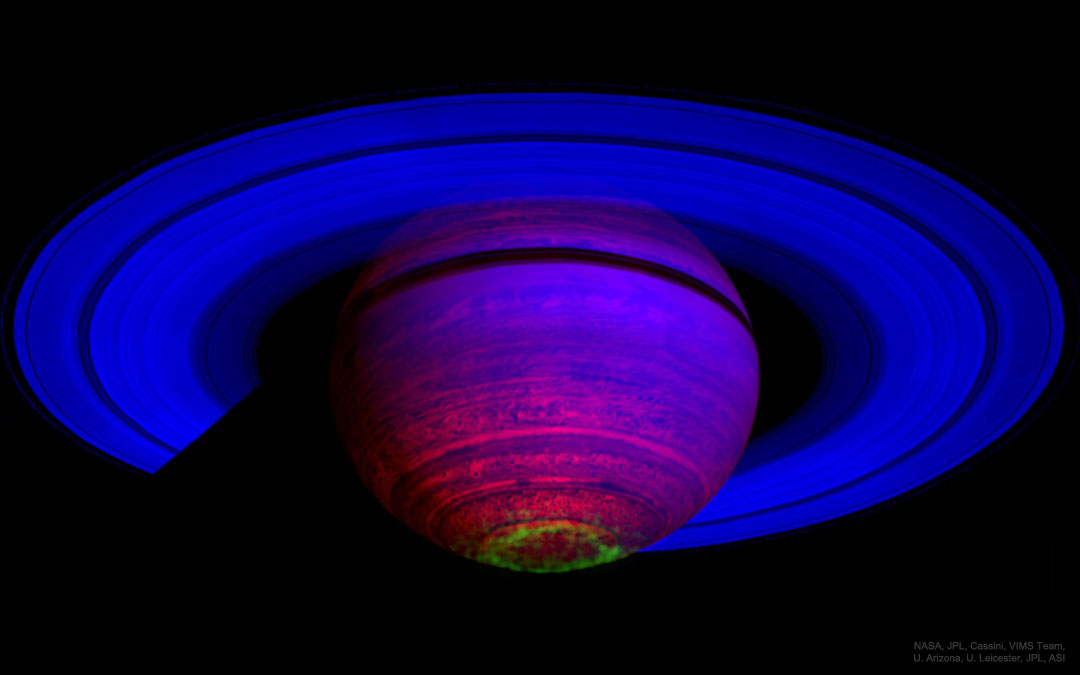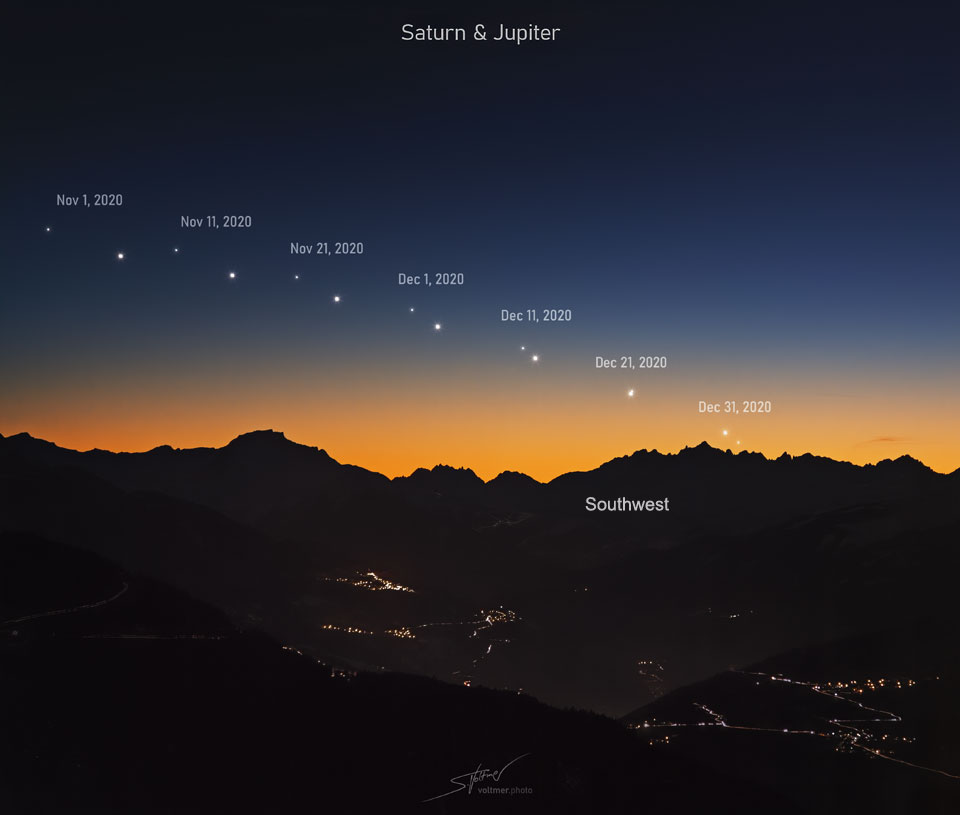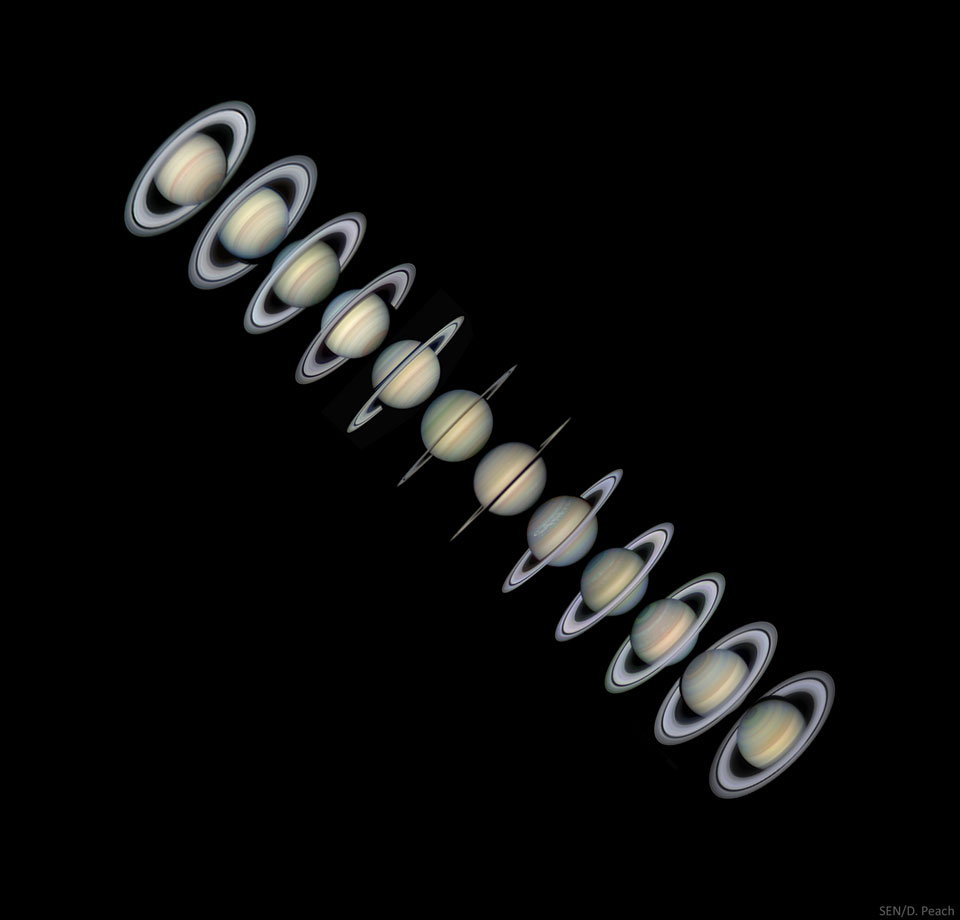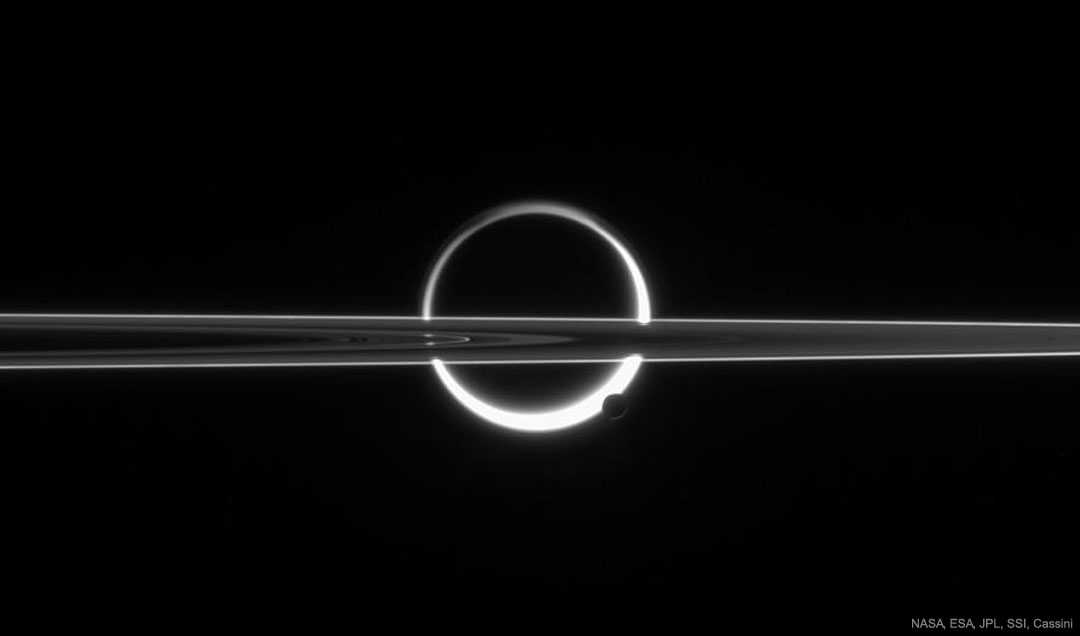
Image Credit: NASA, Cassini, VIMS Team, U. Arizona, U. Leicester, JPL, ASI
Saturn — a majestic Titan, a lord of celestial rings, and a primary reason why people raise telescopes to the sky. To behold the sixth planet of the Solar System, seemingly within arm’s reach, is a truly breathtaking and unforgettable spectacle. Yet, how can one capture this magical view? On this page, you will find the best tips for stunning observations of Saturn through a telescope.
How to Find Saturn in the Sky

Illustration Credit & Copyright: Sebastian Voltmer
Although Saturn is separated from us by an average of 1.3 billion kilometers (it is like flying 200 thousand times from New York to Los Angeles and back), finding it in the sky is easier than it may seem. First, Saturn is a fairly large celestial body, about 9.5 times larger than Earth. Second, it is ringed, which makes it visually even larger. Third, we live in the digital age and have smartphones, laptops, and the internet!
Use any stargazing app such as SkyView, Star Walk, or Stellarium Mobile, or sites like TheSkyLive.com, and they will show you not only the exact position of the planet in the sky in real time but also interesting facts about Saturn. Then, put your astronomer skills to work.
Take a Saturn telescope and set it to the exact celestial coordinates (direct ascension and declination). If you have an auto pointing model (GoTo), it is even easier; just type in the name of the object. Voilà! You are off on a fascinating journey through Saturn astronomy!
When can you see Saturn in a best way
You can see Saturn in a telescope almost all year long, except for the conjunction period, when the Sun is between the Earth and the gas giant and the latter is completely lost in the bright sunlight. Usually conjunction lasts 1-1.5 months, so you will have to have patience because it will be rewarded a hundredfold.
The best time to observe Saturn is in opposition. It is a phenomenon when our Earth is exactly between the Sun and Saturn and becomes as close to it as possible (only 1.2 billion kilometers). Then, Saturn becomes brighter and larger (especially around midnight), and most importantly, visible in the sky all night. True, Saturn in opposition is extremely rare, once every 378 days. But this is no reason to be upset. Before opposition, the planet is best seen in the second half of the night and the morning hours. And after opposition – in the late evening and the first half of the night.
Important! Try to observe Saturn when it reaches its maximum height in the sky. The higher the object is above the horizon, the thinner the atmospheric layer, which means that the image will be clearer and more stable. And, of course, the atmosphere itself should be calm and cloudless. On a clear, dark night, the telescope image will be particularly clear.
Approximate Saturn visibility from the USA in 2025-2026
| Year | Event | Approximate Date (EDT/PDT) | Visibility from the USA |
| 2025 | Conjunction with the Sun | March 12 | Poor/Invisible |
| 2025 | Start of Morning Visibility | Late March/April | Morning |
| 2025 | Opposition | September 21 | All Night |
| 2025 | Evening Visibility | Late Sept – Feb 2026 | Evening (worsening in Feb.) |
| 2026 | Conjunction with the Sun | March 25 | Poor/Invisible |
| 2026 | Start of Morning Visibility | Late March/April | Morning |
| 2026 | Opposition | October 4 | All Night |
| 2026 | Evening Visibility | Early October onwards | Evening |
Note: Exact dates and times of visibility may vary slightly depending on the time zone of your location. For more accurate times, use astronomy apps or websites that take your geographic location into account.
How can you see Saturn without a telescope

Image Credit & Copyright: Damian Peach/SEN
Yes, yes, Saturn can be seen without a telescope. It is one of the five planets in the Solar System visible to the naked eye! However, let’s face it, there is very little experience with such observations. The planet looks pretty much the same as the stars – a bright, shining dot. The only difference is that it almost does not shimmer and has a warm, yellowish hue. This is where the naked eye’s capabilities end. You will not see any rings or disk details. Is not that a reason to get a Saturn telescope to learn more?
What Does Saturn Look Like Through a Telescope?

Image Credit & Copyright: Reddit/HTPRockets
Observing Saturn from a telescope, you will certainly see much more than with the naked eye. However, the details of the image will depend heavily on the optical characteristics of the instrument used.
Small telescope (60-80 mm aperture)
It is almost impossible to distinguish any details of the surface (atmosphere) at this level. Saturn will look like a light pea with small “ears” or a thin line because of the adjoining rings.
Medium telescope (100-150 mm aperture)
In such a telescope, Saturn will look larger, with a visible gap between the rings. The disk of the planet itself may still appear homogeneous, but with good atmospheric conditions and sufficient magnification (100-150x), you can try to see very faint hints of a striated structure – the widest equatorial belts of the atmosphere in the form of a slight darkening or general brightness gradient on the disk. The Rings look more pronounced, with a small bright dot shining nearby – Titan’s brightest companion.
Large amateur telescope (from 200 mm aperture)
Details of the atmosphere are already becoming available through this Saturn telescope. You can more confidently distinguish between pale, low-contrast atmospheric belts (darker bands) and zones (lighter areas). It is visually difficult to see distinct colors, but with a stable atmosphere, differences in hue and brightness between belts and zones will be noticeable. The shadow that the planet casts on the rings is also often clearly visible, and slightly worse is the thin shadow of the rings on the Saturn disk itself. The structure of the rings looks more obvious, and several satellites are visible. This is the most detailed view available from visual observations of the ringed planet.
Observing Saturn’s Rings and Moons
In truth, Saturn would not be as attractive if it were not for its magnificent rings and numerous satellites. Observing these objects in a telescope gives astronomy enthusiasts a particularly exciting experience. But there are a few nuances to consider.
Rings

Image Credit: NASA, ESA, Hubble, OPAL Program, J. DePasquale (STScI), L. Lamy (Obs. Paris)
The main feature of the rings is their ever-changing appearance to an Earth observer. For almost 30 years, while Saturn has made one revolution around the Sun, we have seen its rings from different angles. Every 13-15 years, there comes a moment when we look at them from the side, as if “from the edge”. That is the period we are experiencing now, in the spring of 2025. The rings look like a thin luminous line through the disk of the planet, and in a small telescope, they are very difficult to see, and the famous Cassini Division (the dark band between rings A and B) is hidden from us.
When the rings are tilted more strongly, however, there is an excellent view of their structure. The Cassini Division becomes visible in telescopes from 100-150 mm in a calm atmosphere. And for owners of a large telescope (from 200-250 mm) in dark skies, there is a chance to see the subtle inner C Ring, known as the Crepe Ring.
Moons

Image Credit: NASA, ESA, JPL, SSI, Cassini Imaging Team
The main problem with observing Saturn’s Moons is that their brightness varies enormously, and they are constantly shifting relative to the planet. While Titan is easily visible even in a simple telescope, Rhea, Tethys, Dione, and Iapetus look like 10-11 magnitude stars and require a telescope with an aperture of 100-150 mm or more. Iapetus is also known for its variable brightness: because of its two-colored surface, it is brighter and dimmer.
It is even more difficult to see faint inner moons such as Enceladus and especially Mimas. To catch them, you need a solid telescope to see Saturn (from 200-250 mm), a very dark sky without city lights, perfect transparency and stability of the air, and a lot of patience. Mimas, in addition, gets lost in the brilliance of nearby rings. To understand which of the dim dots you see and not to confuse it with a star, you will need astronomical applications or maps showing the location of satellites in real time.
And yet, despite all the difficulties, detailed observations of Saturn’s rings and satellites provide a truly indelible experience that you will want to repeat again and again.
Pictures of Saturn through a telescope

Image Credit & Copyright: Reddit/oldboy_and_the_sea
Many people, having seen magnificent images of Saturn on the web, expect to see the same in the telescope eyepiece, but see a dim, sometimes shaking from the atmosphere, inexpressive picture. The fact is that astrophotos are the result of complex and painstaking work. Astrophotographers shoot video, select the best frames, stack them and process them to “pull out” details and colors.

Image Credit & Copyright: Reddit/AcrobaticEmergency42
Do you want to try to make the best pictures of Saturn yourself? You will need a good telescope (preferably with a Barlow lens), a camera, a laptop with post-processing programs, and, of course, a detailed guide from experienced astrophotographers.
Tips for a Better Viewing Experience
And while you are learning or honing your astrophotography skills, we offer you some proven techniques that will allow you to get the most out of observing Saturn through a telescope regardless of optics characteristics.
- Choose your observing location: Dark skies away from light pollution are always preferable for seeing the fine details: faint satellites and thin rings. But Saturn is bright, so urban observations from your private observatory on the balcony can also be successful, especially for a general view of the planet and Titan.
- Cool the telescope: expose the equipment to open air for 30-60 minutes, depending on the size of the model. This will allow the optics to accept the surrounding temperature and prevent image blurring due to warm air currents inside the tube.
- Make the telescope stable: A strong, unshakable mount is the key to a clear image, especially at high magnifications. Vibrations will negate the advantages of good optics.
- Adapt your vision to the dark: Wait 15-20 minutes for your eyes to get used to the darkness. Use only a flashlight with a weak red light to illuminate maps or change eyepieces so as not to “throw off” the adaptation.
- Select magnification: Start your search with small values and then use longer focal length eyepieces to find the optimum magnification for the current conditions. Don’t overdo it: too much magnification will make the picture faint and blurry.
- Catch the moment: The atmosphere is rarely perfect, so learn to observe painstakingly and carefully. Wait for “moments of calm” – short moments when the image suddenly becomes sharp and clear. It is in these seconds that fine details can be seen.
- Use hints: Don’t forget the planetarium apps, they can help you not only find Saturn, but also identify satellites or understand the current tilt of the rings.
- Take notes: The more you observe, the more you begin to notice. Keeping a simple observation diary is an important part of amateur astronomy that helps you learn better and track your progress.
By applying these simple practices, you will be able to enjoy Saturn from a telescope much more, seeing the maximum possible for your conditions and equipment.
Arrange a rendezvous with the Lord of the Rings

Image Credit & Copyright: Reddit/Affinity_182
So, no matter how much you admire masterpieces of astrophotography, nothing beats a live view of Saturn in a telescope. Try our tips and see for yourself. The majestic ringed Lord and his cosmic retinue – satellites – are waiting to meet you. And we wish you clear night skies and the most breathtaking views!


